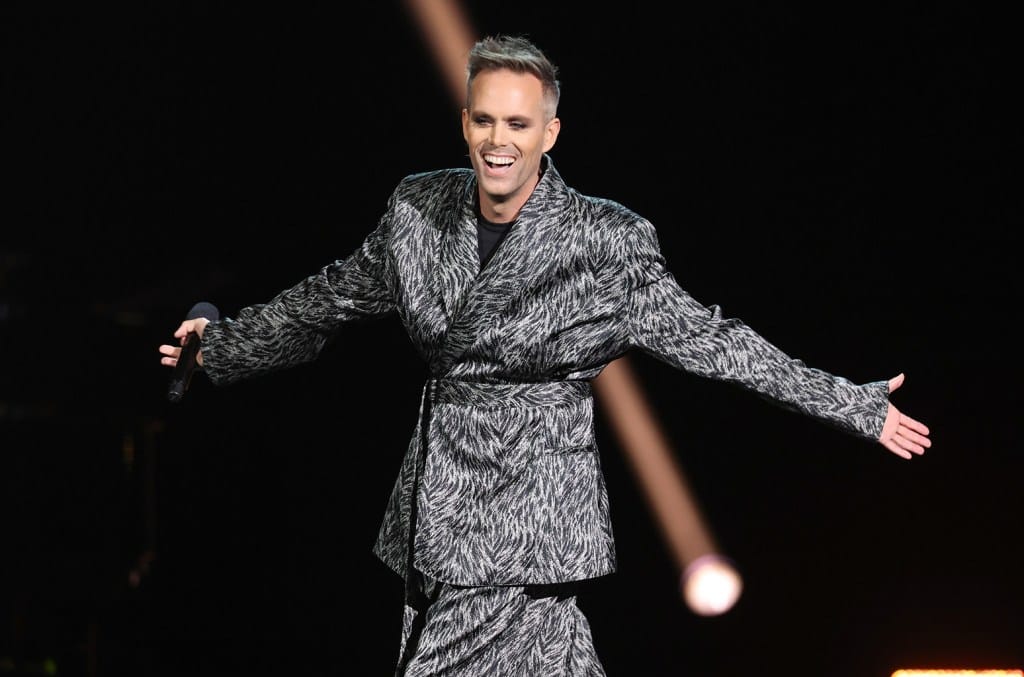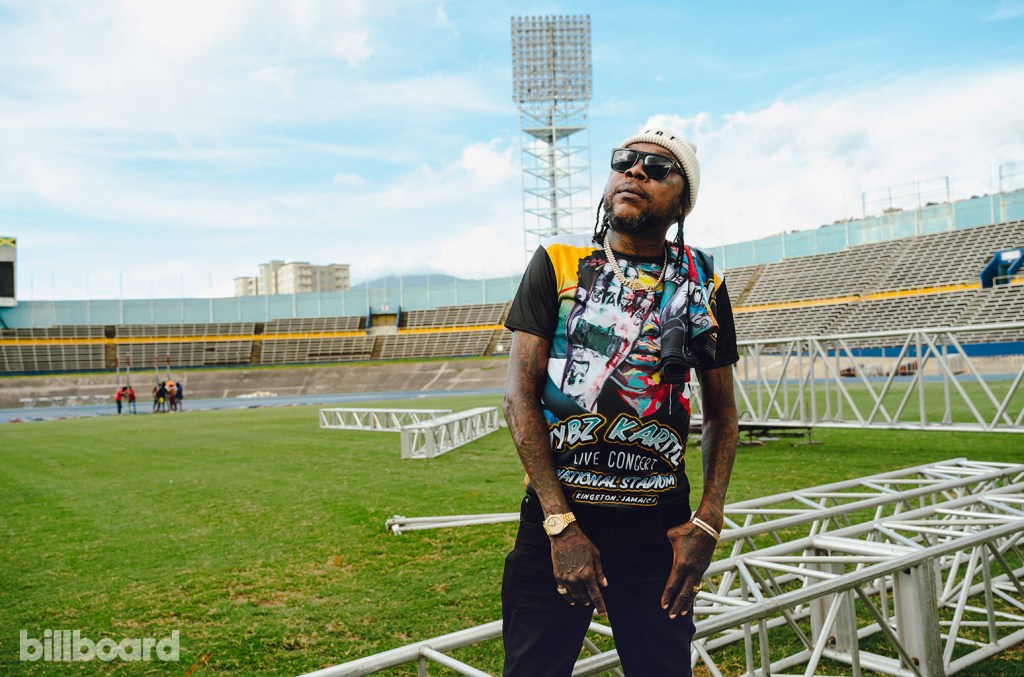Grammys
Page: 15
As fans and artists alike gear up for this Sunday’s Grammys, Chappell Roan is taking a beat to share some gratitude for her fans. In a post to her Instagram on Wednesday (Jan. 29), Roan shared a series of selfies while writing a lengthy note of appreciation to her fans. “Good morning booboos. It’s Grammy […]
Jessi Uribe was putting up the Christmas tree with his children at his home in Colombia when he received the news that he’d been nominated for the 2025 Grammys.
Explore
Explore
See latest videos, charts and news
See latest videos, charts and news
Not only does it mark his first nom at the coveted awards show, but he’s making history along the way as the first artist of música popular Colombiana (or Regional Colombian) to be in the best Música Mexicana album (including Tejano) category with his 2023 LP De Lejitos.
“I didn’t even know what to do when my manager called me crying,” he tells Billboard. “I thought he was playing a joke on me. I’m very happy. I didn’t expect it. We have worked a lot on la música de despecho (heartbreak music) in Colombia and nobody imagined it.”
Trending on Billboard
Since 2008, Uribe has become one of the biggest proponents of música popular, which fuses ranchera and the string music known as carrilera in Colombia. The genre — initially known as música de carrilera or música de cantina — was born more than five decades ago in the country’s coffee region, and first gained traction in small towns and local bars with the help of genre pioneers including Darío Gómez, Luis Alberto Posada and El Charrito Negro.
Now, for the first time in the genre’s history, it’s represented in a Mexican music category at the Grammys against three Regional Mexican powerhouses: Chiquis, Carín León, and Peso Pluma.
“My style is very romantic and I’m very attached to my roots,” he explains. “I feel that Mexican people take that with a lot of respect. I’ve had the opportunity to work with Espinoza Paz, Carín León, Alejandro Fernández, Joss Favela, people who know that I love ranchera music and that I have been a part of it since I was a child. It’s an achievement that even though I’m not Mexican, I’m in a genre that is my life as well. A Colombian who makes ranchera? I think it seemed strange but also nice to the Academy.”
For Uribe, this nomination goes beyond a personal achievement. “[This nomination] puts música popular on the radar of many countries and of people who perhaps saw us as a weak genre abroad,” he says. “I feel that they now see the genre with a little more respect. We are very united in regional Colombian, and this is a dream that [my colleagues] live with me and that we achieved together.”
Following the 67th annual Grammy Awards on Sunday (Feb. 2), Uribe will have a concert at the Hard Rock Live on Feb. 21 in Hollywood, Fla., and says a new album — that he worked on with Favela in Mexico, and includes a collab with Grupo Firme — is on the horizon.
A series of special performances will highlight the 67th Annual Grammy Awards on Sunday (Feb. 2), including a salute to the life and legacy of Grammy legend Quincy Jones, tributes to the spirit of Los Angeles, which is beginning the long process of rebuilding after devastating wildfires, and the annual In Memoriam segment.
Brad Paisley, Brittany Howard, Coldplay’s Chris Martin, current Oscar nominee Cynthia Erivo, Herbie Hancock, Jacob Collier, Janelle Monáe, John Legend, Lainey Wilson, Sheryl Crow, St. Vincent and Stevie Wonder are set to appear in these segments.
Jones, who died in November at age 91, won 28 Grammys across six different decades, from the 1960s to the 2010s. He was a friend and mentor to generations of talented artists, including Hancock, Wonder, Legend and Collier. He won just about every award the Recording Academy has to give, including a trustees award in 1989 and a Grammy Legend Award in 1992.
Trending on Billboard
Live from Crypto.com Arena in Los Angeles and hosted by Trevor Noah, Music’s Biggest Night will be broadcast live on Sunday, Feb. 2, at 8 p.m. ET/5 p.m. PT on CBS. The show will also be available to stream live and on demand on Paramount+.
Previously announced performers include Benson Boone, Billie Eilish, Chappell Roan, Charli xcx, Doechii, RAYE, Sabrina Carpenter, Shakira and Teddy Swims.
The 67th Annual Grammy Awards will be produced by Fulwell 73 Productions for the Recording Academy for the fourth consecutive year. Ben Winston, Raj Kapoor and Jesse Collins are executive producers.
Prior to the telecast, the Grammy Awards Premiere Ceremony will be broadcast live from the Peacock Theater at 12:30 p.m. PT and will be streamed live on the Recording Academy’s YouTube channel and the Grammy website.
Justin Tranter, a Grammy nominee for song of the year for co-writing Chappell Roan’s “Good Luck, Babe,” is set to host the Premiere Ceremony. Tranter also hosted last year’s Premiere Ceremony, where the vast majority of Grammys are presented.
The opening number on the Premiere Ceremony will feature a performance by current nominees Yolanda Adams, Wayne Brady, Deborah Cox, Scott Hoying, Angelique Kidjo, and Taj Mahal. Six other current nominees — Joe Bonamassa, Joyce DiDonato, Béla Fleck, Renée Fleming, Muni Long and Kelli O’Hara — are also set to perform, as is Grammy-winning contemporary classical composer Kevin Puts.
This year’s Premiere Ceremony, to be held at Peacock Theater at the LA Live complex in Los Angeles, will stream live at 3:30 p.m. ET/12:30 p.m. PT on the Recording Academy’s YouTube channel and on the Grammy website.
As announced last week, this year’s Grammy telecast will carry an added sense of purpose: raising additional funds to support Los Angeles wildfire relief efforts and honoring the bravery and dedication of first responders. Since launching the Los Angeles Fire Relief Effort to Support Music Professionals last week, the Recording Academy and MusiCares have raised and pledged more than $4 million in emergency aid to music people affected by the wildfires.
On Grammy Sunday, fans can access exclusive behind-the-scenes Grammys content, including performances, acceptance speeches, interviews from the Grammy Live red-carpet special, and more on the Grammy website.
Justin Tranter, a Grammy nominee for song of the year for co-writing Chappell Roan’s “Good Luck, Babe!,” is set to host the 67th annual Grammy Awards Premiere Ceremony on Sunday (Feb. 2). Tranter also hosted last year’s Premiere Ceremony, where the vast majority of Grammys are presented.
This year’s Premiere Ceremony, to be held at Peacock Theater at the LA Live complex in Los Angeles, will stream live at 3:30 p.m. ET/12:30 p.m. PT on the Recording Academy’s YouTube channel and on live.GRAMMY.com.
The opening number will feature a performance by current nominees Yolanda Adams, Wayne Brady, Deborah Cox, Scott Hoying, Angelique Kidjo and Taj Mahal. Six other current nominees – Joe Bonamassa, Joyce DiDonato, Béla Fleck, Renée Fleming, Muni Long and Kelli O’Hara – are also set to perform, as is Grammy-winning contemporary classical composer Kevin Puts.
Trending on Billboard
Harvey Mason jr., Recording Academy and MusiCares CEO, and Tammy Hurt, chair of the academy’s board of trustees, will provide opening remarks.
“The Premiere Ceremony will not only kick off our Grammy Sunday, it will provide an opportunity to show that in times of adversity, music has the power to be used for good, to help our community unite, and to show our community’s resilience,” Mason said in a statement.
This year, both the Premiere Ceremony and main Grammy Awards telecast will have an added sense of purpose: raising additional funds to support Los Angeles wildfire relief efforts and honoring the bravery and dedication of first responders.
The 67th Grammy Awards Premiere Ceremony is produced by Branden Chapman, Ruby Marchand, Lindsay Saunders Carl and Rex Supa on behalf of the Recording Academy. Greg V. Fera is executive producer and Cheche Alara is music producer and music director.
SiriusXM will be backstage during the ceremony capturing interviews with nominees and winners for their Grammy Sunday broadcast on The Grammy Channel, channel 17 and on the SiriusXM app.
The 67th annual Grammy Awards will broadcast live following the Premiere Ceremony on CBS and streaming live and on-demand on Paramount+ from 8-11:30 p.m. ET/5-8:30 p.m. PT.
Performers
Yolanda Adams, Wayne Brady, Deborah Cox, Scott Hoying, Angelique Kidjo, and Taj Mahal (opening number)
Joe Bonamassa
Joyce DiDonato
Béla Fleck
Renée Fleming
Muni Long
Kelli O’Hara
Kevin Puts
Presenters
Wayne Brady
Bob Clearmountain
Rhiannon Giddens
Scott Hoying
Jimmy Jam
Anoushka Shankar
Queen Sheba

As we near the 2025 Grammy Awards this Sunday, predicting what will happen in the Big Four categories — album, record and song of the year, along with best new artist — feels more challenging than ever. Could Chappell Roan sweep the Big Four? Or could it be Beyoncé’s time to notch her first win […]
When 2024 turned out to be one of the most densely packed years for pop music releases in recent memory, it was a given that the following year’s Grammys would be extremely competitive. But as the days close in on Sunday’s ceremony, the face-off is starting to feel more and more contentious — especially in the album of the year category.
In 2025, some of pop’s most established titans are squaring off against breakout newcomers and tastemakers in the category, with no clear front-runner to speak of. For starters, last year’s winner Taylor Swift returns to the fold in 2024, this time with her 17-week Billboard 200-topper The Tortured Poets Department. If the prize was awarded based on sales, the Eras Tour headliner would have it in the bag, having recorded the second-highest first-week numbers in history — 2,610,000 units, to be exact — with her sprawling 11th studio record the in April last year. She’s also the reigning AOTY winner, taking home the award a record fourth time in 2024 for the year prior’s Midnights.
But Beyoncé is also in the race for the fifth time in her career, this time thanks to Cowboy Carter. Some people think that the critical acclaim of the country-bending, genre-exploring LP — which features all-star cameos from Dolly Parton, Willie Nelson, Post Malone, Miley Cyrus and more greats — might be the project to finally get the “Texas Hold ‘Em” singer that AOTY honor, which would become the crown jewel of her already record-high Grammy count (32 total).
Trending on Billboard
But three of last summer’s most talked-about ladies also share the category with Bey and Tay: Sabrina Carpenter, Chappell Roan and Charli XCX. All three women ruled the charts last year with their respective projects, with Short n’ Sweet, The Rise and Fall of a Midwest Princess and Brat, respectively, all spawning year-defining viral hits and turning their creators into superstars.
And those are just a few of the heavyweights included in this year’s album of the year category, which will also see Grammy darling Billie Eilish‘s Hit Me Hard and Soft face off against André 3000‘s New Blue Sun and Jacob Collier‘s Djesse Vol. 4. Opinions about who should actually take home the coveted gramophone are rampant, but only Recording Academy voters can decide the fate of the nominees.
Except for here, where your voice is the one that matters: Tell Billboard which project you hope to see win album of the year at the 2025 Grammys by casting your vote in the poll below.
Nominees: Take It Easy (Collie Buddz); Party With Me (Vybz Kartel); Never Gets Late Here (Shenseea); Bob Marley: One Love – Music Inspired By The Film (Deluxe) (Various Artists); Evolution (The Wailers)
Technically, there are only two original reggae albums nominated here this year. Incredible.
Vybz Kartel and Shenseea scored their first career nominations for their own music this year with Party With Me and Never Gets Late Here, respectively, both dancehall records. Reggae legend Bob Marley is represented through the One Love soundtrack, which features covers of Marley classics from several artists, including Grammy winners Kacey Musgraves, Daniel Caesar, Leon Bridges and Wizkid.
Collie Buddz’s Take It Easy and The Wailers’ Evolution are the remaining nominees. This is Buddz’s second nod in this category in as many years, while Take It Easy features contributions from Caribbean music giants such as Bounty Killer, B-Real and Demarco. The Wailers — formed by former members of Bob Marley’s backing band — are nominated with Evolution, which hit No. 5 on Reggae Albums.
As previous nominees, Shenseea and The Wailers are likely the frontrunners here, but keep an eye out for Vybz Kartel. Last summer (July 31, 2024), the King of Dancehall walked out of prison a free man after serving 13 years of a now-overturned life sentence for the murder of Clive “Lizard” Williams. By New Year’s Eve, the legendary deejay mounted Freedom Street — his first performance since his release, and the biggest concert the country had seen in nearly 50 years. Though Party With Me lacks an all-out smash à la “Fever” and “Clarks,” Kartel’s narrative may prove too irresistible for any of his competitors to put up a fight. The Freedom Street concert dominated social media, but it happened near the very end of the voting period (Jan. 3), when many voters had presumably cast their ballots already.
Shenseea is probably his stiffest competition here. Never Gets Late Here reached No. 4 on Reggae Albums and incorporates notes of pop-dancehall, R&B, rap, Afrobeats and, most importantly, reggae. With Grammy-approved producers like Di Genius, Tricky Stewart, Ilya, Stargate and London On Da Track in tow, Never Gets Late Here could muster up enough support to pull ahead of Worl’ Boss.
Nonetheless, there’s also a scenario in which Marley’s legend and the film’s box office success lifts the One Love soundtrack to a victory — even if the more exciting win would be Buddz’s project. Traditional reggae projects tend to triumph here anyway, which counts against Kartel and Shenyeng despite their strengths elsewhere.
Prediction: Vybz Kartel, Party With Me
Look Out For: The Wailers, Evolution
Listening to Jacob Collier’s star-studded Djesse album series, now on its fourth installment, can feel like attending the most expansive, open-minded music festival you’ve never heard of — with a roster of guest artists spanning contemporary hit-makers, instrumental legends and global choruses and orchestras. But though Collier’s recordings have become as known for their diverse array of big-name guests as his own presence, his full-lengths weren’t always defined by collaboration.
“The first album I ever made, In My Room, was an album written, recorded, arranged, produced and mixed entirely alone, and my first world tour of this album was with a one-man show,” explains the 30-year-old studio savant of his 2016 debut album. The solo experience sufficiently convinced him there might truly be strength in numbers: “By the end of that process, I was deeply ready for collaboration.”
Trending on Billboard
The guest-heavy Djesse sets — pronounced “Jay Cee,” like Collier’s initials — have yielded two album of the year nods for the performer-writer-producer, including this year for 2024’s Vol. 4, the series’ final entry. “I’m sure the heart of my world will always be, in part, in my little room where the journey first began, in that solitary sanctuary,” he reflects. “But more than ever, collaborating feels like a big part of what I am here for.” These are just some of the names who’ve entered the Collier Constellation — on Djesse Vol. 4 and beyond.
AESPA
Collier knew the best-selling South Korean quartet, who he calls “one of the most adventurous and contemporary K-pop groups I’ve ever heard,” would be the perfect match for the “galactic multigenre form” of Vol. 4’s “Over You.” “Plus,” he adds, “we’re all Crocs fans, so it was meant to be.”
Anoushka Shankar
The British American sitar luminary (and daughter of sitar legend Ravi Shankar) lends her “incalculable greatness and magic” to the rousing “A Rock Somewhere,” which Collier says allows the song to “bridge effortlessly from the ancient and classical to the sparkling modern.”
Brandi Carlile
Collier first met fellow Grammy darling Carlile through Joni Mitchell, when Carlile invited Collier to Mitchell’s house to privately sing her song “Little Green” to her as she recovered from a brain aneurysm. So for a song called “Little Blue” on Vol. 4, “it felt only right to invite Brandi to offer her inimitable storytelling magic [to the song].”
Camilo
“Camilo is pure joy in human form!” Collier raves of the Colombian pop hit-maker, whose bilingual crooning leads “Mi Corazón.” “His ability to hop between Spanish and English is next level. He brings an incredible energy to everything he touches… and his moustache is a bonus.”
Chris Martin
Chris Martin and Jacob Collier
Michal Augustini
Collier says the Coldplay frontman, who sings on “Over You,” has become “like a brother” since they met in 2019: “With a presence and openheartedness that’s so transformative, he’s the kind of mentor everybody should have.”
Chris Thile
Chris Thile and Jacob Collier
Fran Haincourt
The Nickel Creek mandolinist, whom Collier calls “a true master of his craft,” lends his plucking to “Summer Rain,” alongside fellow alt-folker Madison Cunningham. “[He’s] my ultimate dueling partner,” Collier adds, “yet somehow, we connect so deeply on a musical level.”
Daniel Caesar
The R&B star lent his buttery vocals to Vol. 1’s nu-soul jam “Time Alone With You.” Collier says recording with Caesar “felt like having a friend come over to hang out after school. He’s that rare combination of incredibly cool and incredibly warm — one of the leading lights of this generation of artists, yet so down to earth.”
Dustin Yellin
A project as sprawling as Djesse needed ambitious artwork to match, and for that, Collier enlisted artist Yellin to create a “30-sheet glass sculpture, with more than 3,000 miniature cut-out paper elements glued within and between the sheets, to form a three-dimensional silhouette of the ‘Djesse head,’ ” which has been featured on all four series volumes. “He’s a maverick, a legend and a master world-builder,” Collier gushes.
John Mayer
Jacob Collier and John Mayer
Courtesy Jacob Collier
Collier was ecstatic to have the superstar singer-guitarist lend his “master touch” to a six-string solo on gentle ballad “Never Gonna Be Alone,” also featuring Lizzy McAlpine’s vocals. “John’s the master of tone, taste and impeccable phrasing… And a top gent, to boot.”
Kimbra
Another close friend and regular collaborator, the New Zealand singer-songwriter did not appear on Vol. 4, but she did jam with Collier as a special guest on the North American leg of the accompanying world tour. “She is such a tour de force in music,” he raves. “A firecracker of a writer, singer and world-builder.”
Kirk Franklin
After making a pact on the 2022 Grammys red carpet to work together, the contemporary gospel legend sang on and/or lent direction of his eponymous Singers to multiple Vol. 4 tracks. Collier says his day in the studio with Franklin in Arlington, Texas, “changed my life… The community and energy surrounding him is nothing like I’ve ever seen.”
Metropole Orkest
The “mighty Dutch bunch” has provided backing for the Djesse series since its beginning, with Suzie Collier conducting it on Vol. 4. He says the “shape-shifting, multigenre” ensemble has “played a pivotal part [in] my musical journey, both onstage and in the studio.”
Michael McDonald
The undisputed King of Yacht Rock maintains his own legacy of unexpected collaborations on “Wherever I Go,” where his “iconically unmatched vocal tone” powers what Collier calls “a bit of an homage to the music [fellow guest singer] Lawrence and I grew up listening to.”
The Mystery of the Bulgarian Voices
Jacob Collier (center) and The Mystery of the Bulgarian Voices.
Courtesy Jacob Collier
A fan of this choir since he discovered it as a teen, Collier calls snagging the group for “All Around You” on the Vol. 4 deluxe edition a “bucket-list collaboration. Their sound is life-changing — 25 singers from 12 regional traditions, all coming together to create something so pure, agile and breathtaking.”
Oumou Sangaré
“A Malian Wassalou icon” who has appeared on multiple Djesse sets — most recently as part of a global all-star lineup of guest vocalists on Vol. 4’s “Box of Stars Pt. 2.” — Sangaré’s presence was “so majestic,” Collier says, “the room felt so small in comparison.”
Rapsody
The Grammy-nominated North Carolina MC “brought so much depth and magic” to Vol. 3’s “He Won’t Hold You,” providing what Collier calls her “rare mixture of ultra-hip and ultra-heartfelt” rhymes.
Steve Vai
The legendary 64-year-old axeman for Frank Zappa and David Lee Roth is now a very dear friend who has taught Collier about “everything from chords to Zappa to philosophy to the nature of [the] music business.” Vai plays on three Vol. 4 tracks, on which Collier calls his “wild mastery… nothing short of astounding.”
Suzie Collier
Jacob and Suzie Collier
Michal Augustini
Collier’s mother — an internationally known conductor and his “first collaborator as a human being” — has worked with him since Djesse’s first installment, and she conducted on multiple Vol. 4 tracks: “My dear mother has taught me more about music than almost anybody I can think of,” he says. “Her musical sensitivity and mastery has shaped so much of who I am.”
Tori Kelly
Since they became friends in 2017, the artist Collier calls “arguably the most gifted vocalist on the planet right now” has appeared on multiple tracks of his, including Vol. 4’s stirring a cappella rendition of the pop standard “Bridge Over Troubled Water,” also featuring John Legend.
This story appears in the Jan. 25, 2025, issue of Billboard.
For the past five years, producer D’Mile has been on a hot streak. In 2021, he won a song of the year Grammy for his work on H.E.R.’s “I Can’t Breathe.” Shortly after, her “Fight for You” (from the film Judas and the Black Messiah) won D’Mile and H.E.R. the Academy Award for best original song. Then, in 2022, he became the first songwriter to score back-to-back song of the year Grammy wins when Silk Sonic’s “Leave the Door Open” took home the prize. And now, he could potentially claim that same landmark award again: He’s nominated for it at this year’s Grammys for his collaboration with Bruno Mars and Lady Gaga on the retro power ballad “Die With a Smile” — one of three nods he received, in addition to producer of the year, non-classical and best engineered album, non-classical (for Lucky Daye’s Algorithm).
But for the artist born Dernst Emile II — who, at 40, has now accumulated 20 career Grammy nominations — what may seem like overnight success actually took nearly two decades.
Trending on Billboard
His entry into the music industry was in many ways charmed. His late mother, Yanick Étienne, was a singer who toured with Bryan Ferry and Roxy Music, while his namesake father still works as a music producer and teacher. D’Mile himself joined the business at 19 and notched his first production credits in 2005 on projects by Rihanna and Mary J. Blige, before pop-R&B heavyweight Rodney “Darkchild” Jerkins (Destiny’s Child, SZA) took him under his wing as a mentor. In the years that followed, D’Mile logged songwriting and production credits for Janet Jackson, Justin Bieber and Usher, among others.
But for D’Mile, “chasing what was hot to get on projects” during those early days wasn’t satisfying. “I was slaving away making five to 10 tracks a day,” he recalls today, sitting in the cozy reception room in his Burbank, Calif., studio. “But things weren’t moving at the pace I would have liked.”
In 2008, he decided to take a mental break and recalibrate. He amicably ended his publishing agreement with Jerkins and made a pledge to himself: to do “what I love, and if it goes anywhere or doesn’t, it’s something I’m proud of.” Lo and behold, things started falling into place that had seemed elusive — like getting more opportunities to work directly with artists instead of “guessing and throwing spaghetti against the wall” when pitching songs. In turn, D’Mile was able to foster long-term relationships with future Grammy winners like Victoria Monét and Daye.
Despite that positive momentum, D’Mile still considered quitting around eight years ago, after “reaching a point of frustration” with industry politics. “It seemed like it was more of a popularity contest or knowing the right people to get in certain rooms or positions that I’d worked so long for,” he says. “I just felt like things weren’t progressing.” He posted his feelings on Instagram Stories, which elicited supportive comments from friends and colleagues telling him that he couldn’t give up.
That’s where Daye came in. Then only a songwriter, he told D’Mile that he wanted to become an artist in his own right — and to bring D’Mile on for a project. “Doing what we wanted to do was a life-saving kind of project for me,” D’Mile recalls of producing and co-writing what became Daye’s 2019 debut album, Painted, which then went on to receive a Grammy nod for best R&B album. “That was the battery in the back that I needed,” he says. In 2022, Daye’s Table for Two, which D’Mile executive-produced, won the Grammy for best progressive R&B album; now, the singer’s third studio set with D’Mile, Algorithm, is vying for best R&B album (which could give D’Mile another Grammy if Daye wins) and best engineered album, non-classical.
Joel Barhamand
What role have your Grammy wins played in your career thus far?
It’s funny. Every time Grammy season comes around, I’m always nervous. I’m so grateful to have the wins, but then I’m like, “One day, that’s going to stop.” With these new nominations, I’m happy that people still like what I do. The attention you receive is something I had to get used to, especially the first time, because I’m kind of a quiet guy. My phone was blowing up and I had to do interviews. It was crazy. But I also feel it has made things easier because a lot of people are coming to me more than I’m trying to get to them, which is great. Yet navigating that can also be overwhelming.
What do you feel is the secret behind your success as a songwriter and producer?
I always just try to bring out who the artist is by getting to know them. It could be a conversation that sparks something before we start or while we’re working together. Or I’ll hear a conversation between the artist and another songwriter, and I’m feeling the vibe, feeling them both out. I like to say that I don’t talk; I listen. And when I create, it’s like my interpretation of who the artist is.
You’re in strong company in the producer of the year, non-classical category this year. Is there more camaraderie among producers now compared with when you were coming up?
Growing up in this business, and being with Rodney, I feel like it was way more competitive back then. And maybe some people might feel that’s better, but it can be negative to be so competitive. I’ve heard horror stories about what people can do just to get something over somebody else. For me, even though I’m up against you, we could probably work together tomorrow — so let’s do something great together. I don’t think that was happening as much back in the day.
I’ve worked before with Mustard. And Dan Nigro and I always talk. I’m such a big fan of his and what he’s done with Chappell Roan and Olivia Rodrigo. I met Alissia a few years ago; it’s great that a female has been nominated. I know a lot of people might not know her, but she’s super-talented. I haven’t met Ian Fitchuk yet but I have heard his work. I learned that he’s a fan of me as well, and that’s cool.
What kind of change would you like to see the industry as a whole embrace?
Streaming is the biggest way that people are listening to music, but it’s not translating that way for songwriters and producers. We’ve just got to make it make sense. That’s the main thing as far as income is concerned. I’ve donated to small companies that are fighting for that, like the organization a friend of mine, Tiffany Red, founded called The 100 Percenters. It advocates for the rights of songwriters and producers. I want to get more involved in that fight for sure.
Given the hot catalog-sales climate, have you been approached about selling yours?
People have talked to me, but it’s never gone as far as “I want to do a deal with you.” I guess it’s situational. Yet in the grand scheme of things, why would you do that? But I don’t know… I’m still learning about all of it at this point.
As one of today’s principal architects of R&B, what’s your take on the state of the genre in 2025?
The most important thing is really caring about the song that you’re writing as an R&B artist. There’s a lot of great stuff happening, but sometimes I feel like some R&B songs topicwise only cater to a certain demographic of people. It’s about finding the balance in keeping the integrity of R&B/soul while making it so that all walks of life can relate. Toxic R&B, that’s a Black thing, and I don’t know how much many other people in the world relate to that. So I think it’s important to make a great song but leave it open a little more for interpretation. We just need to make songs that connect with more people. Then if the songs are more open, it will cause a domino effect. I would like to think that there isn’t really a wall for us not to get bigger than we can be. We’ve just got to be more intentional and not comfortable with where we are. That will change the game, because the industry just follows what’s making the most money. And I feel there’s a world where R&B will be that.
This story appears in the Jan. 25, 2025, issue of Billboard.
The 2025 Grammy Awards are just around the corners, which means one of this year’s breakthrough stars will be crowned best new artist. This year’s nominees include Benson Boone, Sabrina Carpenter, Doechii, Khruangbin, RAYE, Chappell Roan, Shaboozey and Teddy Swims. Carpenter and Roan join an impressive club of artists who have been nominated in all […]

 State Champ Radio
State Champ Radio 









